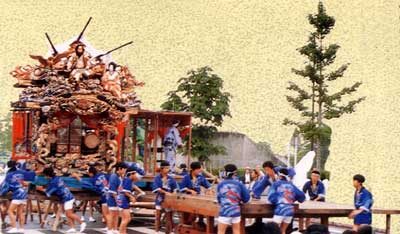Yama-age festival is held on 4th Saturday in July following Friday, Saturday, and Sunday.
The Yama-age festival is said to data from 1560, when Suketane Nasu, the lord of the Karasuyama castle deified Susano-no-mikoto, the brother of the Su-goddess to drive out the plague. In Shintoism he was believed to be potent in amelioration of health. The Kaduki drama performed as a dedication has become transmuted into the Yama-age festival of today.
The central characteristics of it are yama floats, mikoshi or a sacred palanquin and yatai or a kind of float decorated with elaborate engravings. For 3 days about 150 people are necessary to operate them.
Other floats except yama are stored in the exclusive warehouse, which each area of the town has. Yama (litarally mountain) are stage settings section used as a background. Made of enormous Karasuyama Japanese paper and flour paste, they are transformed into grand mountains.
Many years ago so much flour paste was used that the price of flour soared up during the summer.
On July 25, odori-dai (the stage) is installed in front of the three different-sized yama floats on the street of the town. During the Kabuki performance by female dancers in gorgeous kimonos, yama floats set at intervals about 30 meters change variously to the wooden clappers of Kigashira (conductor). Afterwards everything folded and carried to the next street to be acted on.
It is also amazing and enjoyable that many waka-shu (young townspeople are supporting the festival) move briskly in order. The principal features of the play are Masakado, Modori-bashi, Munekiyo, Tadanobu, Umekawa, Sekino-to (Tokiwazu or kabuki play).
Yama-age, the incomparable open-air spectacle was designated as the national cultural assets in 1963.
Origin of the Yamaage festival
Masakado
In 12C A.D.Masakadommodo Taira, the lord of baronial family took up arms against the Emperor and ruined in Tohoku area. The play wax a spectacle written on the ground of the historical fact.
Mitsukuni (hero), an inspector sent by the Emperor stole into the castle where Takiyasha (heroine), the daughter of Masakado Taira.
The scene begins in a room of the castle. Takiyasha disguized herself as a beautiful Kisaragi or a geisha and comes up to him on the purpose of winning him over to her side. While they are talking, he finds that she is a daughter of Masakado.
Takiyasha, after disclosing her identity, she fights against him by means of Gama (toad) magic.
Mikoshi is thought and treated as God during the festival. The God on Mikoshi is thought and treated as God during the festival. the God on Mikoshi is brought out of the shrine for 3 days and enjoys the play with the townspeople.
yoimatsuri (the eve of the festival)
All of wakashu (staff) get together in kimonos to inspect the floats and practice the play.
shitsugyo
At six in the morning Mikoshi is moved to Okarijo or the temporary shrine in the center of the town. The first play is performed there.
togyo
From seven A.M.Mikoshi is preceded a group of men in festival costumes around the town.
kangyo
Mikoshi starts at five A.M.from the temporary shrine and goes back to the Yakumo shrine around eleven P.M.which is called Omiya-iri or entering shrine. At the same time the last play Sekino-to is acted.
Gohai (a box -like float)
Gohai is the place where Ohayashi or musical band play Gionbayashi music. It is decorated with minute engravings. Yama floats are fixed on wooden framework and supported by sandbags.
Nami (wave)
Three pairs of waves are set to produce a stereoscopic effect
Yakata (house)
It has contraption appearing in accordance with the movement of yama.
Butai (carrier)
Butai is used both as a carrier of the stage settings and the foundation. During the performance of the play. several pieces of board are laid on it. By the side of the hanamichi (stage passage) is installed. It has 4 small wheels (60cm high,21cm wide), which is used for the purpose of transporting.

Yama is made by attatching several Haritsuka (360cm by 360cm part of yama) to a wood framework. Haritsuka is pasted by Japanese paper (produced in karasuyama) on the plaited bamboo sheets.
Three different-sized yama floats are set at intervals of 30 meters. Other floats Yakata, Hashi Nami,Zashiki are located from Odoridai as above.
Contraptions Seriage….lifting up (to lift the part of yama and an actress) Seridashi….pushing out (to push out the actress) Kirikaeshi….switching (to change background) Hishigi….revolving
Taki….fireworks and electric lights to express water.
Yama’age Kaikan (Yamaage center)
Nasu-Karasuyama Tourism, Karasuyama Branch is located in Yama’age Kaikan (Yamaage center). Yamaage festival is held in summer here. Visitors to the Yama’age Kaikan can view yatai (outdoor stalls) actually used in the Yama’age Festival, which the hall has set up to make the festival more widely known. Visitors are encouraged to take commemorative photos in front of the yatai. Images of the festival projected onto a giant screen make for a dramatic sight that will surely make you want to go and see the real thing in summer for yourself.
Address and Contact:
Yama’age Kaikan (Yamaage center) Nasu-Karasuyama Tourism, Karasuyama Branch 2-5-26 Kanai, Nasukarasuyama, Tochigi Prefecture 321-0628, Japan Tel: 0287-84-1977 Fax: 0287-84-1978
Yama’age Kaikan (Yamaage center) Website: http://park18.wakwak.com/~omotenashi/
Nasukarasuyama (Karasuyama) Yama-age festival 2-5-9 Kanai, Nasukarasuyama City (Nasukarasuyama-shi), Tochigi Prefecture 321-0628, Japan Tel: 080-2563-2250 Fax: 0287-83-8177
Nasukarasuyama (Karasuyama) Yama-age festival Website: http://www.karasuyama.info/ and http://www.yamaage.jp/


